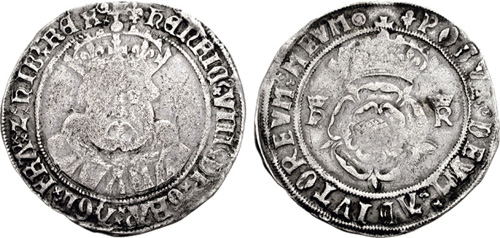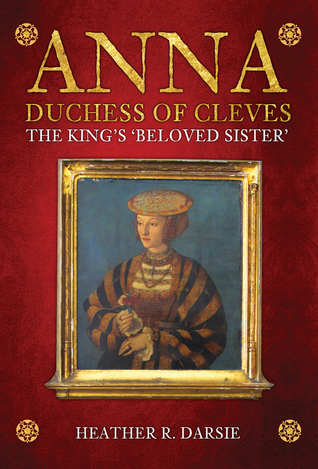
At the beginning of Henry VIII’s reign in 1509, there were three different coins used as currency. The coins and their value were roughly as follows: silver penny, the lowest; a silver groat (worth four pennies/pence); gold angel (worth 120 pence/10 shillings); and gold half-angel (worth 60 pence/10 shillings). The value of these coins remained the same from 1509 to 1526. Henry VIII reformed the monetary system beginning in 1526, including introducing new gold coins, the crown and half-crown. Silver coins minted from 1526 to 1544 featured reduced metal content. The gold angel’s metal content remained the same up through the end of Henry’s reign in 1547.
In May 1542, Henry VIII issued an indenture that slowly reduced the amount of silver in pennies and groats, and reintroduced the silver testoon which his father Henry VII tried to introduce. The indenture was kept secret, but minting of the new, debased coins was in full swing for two years before they entered the economy. The testoon was produced around 1489, and not many were made. The original testoons were reintroduced by Henry VIII in 1544, and it remained in circulation until 1551. Testoons were made of silver, and eventually became known as shillings.
Coins can be measured in weight and in fineness. The weight is the actual weight of the coin, and the fineness is the percentage of pure silver or pure gold in the coin. From 1544 onward, the weight and fineness of coins minted during Henry VIII’s reign declined. The Penny started off in 1509 weighing 12 grains, with a fineness of 11oz 2dwt. By 1526, the weight dropped to 10 grains, but the purity remained the same. For the final minting in Henry VIII’s reign, the Penny weighed 10 grains but the fineness dropped by more than eighty percent to 4oz to 6 oz of silver in the coin.
The Groat experienced a similar degradation, but lost only about sixty percent of its fineness. From 1509 to 1526, the coin weighed 48 grains, with the same fineness as a Penny of 11oz 2dwt. The size of the coin dropped considerably to 42 grains between 1526 and 1544, but had the same fineness. At the end of his reign, the Groat weighed only 40 grains, and had the same fineness of the silver Penny at 4oz to 6oz.
As part of what became known as the Great Debasement, Henry introduced the Half-Sovereign and Sovereign gold coins in 1544 as well. The Sovereign was another coin originally introduced by Henry VII in 1489. From the size of the Sovereign coins under Henry VII, it is assumed that the Sovereign was not intended for general circulation.
Fineness of the gold Half-Sovereign and gold Sovereign coins was reduced in 1545, and again in 1546. The Half-Sovereign started at a weight of 6.48 g (a gram is roughly the same weight as a paperclip, so the Half-Sovereign weighed about the same as 6.5 paperclips) and fineness of .958, making the coin 23 carat gold. The 1545 and 1546 Half-Sovereigns weighed less at 6.22 g, and their fineness dropped from 22 carat gold in 1545 to 20 carat gold in 1546.
The Sovereign had a similar trajectory. For its first issuance, the coin weighed 12.96 g and was made of 23 carat gold. The 1545 and 1546 editions both weighed 12.44 g, but the fineness dropped in both years first to 22 carat gold in 1545, and then to 20 carat gold in 1546.
The Great Debasement was a way for Henry to raise money. Often, much cheaper copper was used to make up the rest of a silver coin’s weight. This cheaper, less valuable currency was stamped with a portrait of Henry on the obverse and either his coat of arms or the crowned Tudor rose on the reverse. The silver would rub off of Henry’s nose during the regular wear and tear a coin undergoes. When the silver rubbed off, the copper shown through, leading to Henry earning the nickname of, “Old Coppernose”.
The only coins whose weight and fineness were not debased were the gold Angel and Half-Angel.
The impact of the Great Debasement continued under Edward VI, and was not righted until the reign of Elizabeth I.
Love learning about the Early Modern period? Are you interested in Tudor history or Women’s history? Then check out my book, Anna, Duchess of Cleves: The King’s ‘Beloved Sister’, a new biography about Anna of Cleves told from the German perspective!
Sources & Suggested Reading
- Wheeler, Heather Y. “Tudor Money and Finance”. https://www.tudornation.com/tudor-money-and-finance/#:~:text=At%20the%20beginning%20of%20the,cutting%20a%20penny%20in%20half. Accessed 1 February 2021.
- “The Testoons of Henry VIII”. https://www.amrcoins.com/information-and-articles/the-testoons-of-henry-viii/ Accessed 2 February 2021.
- Mackie, John Duncan. The Earlier Tudors, 1485–1558. Oxford: Oxford University Press (1963).

[…] in 1542, Henry began a series of reforms of the currency in England which were collectively called “The Great Debasement”. The consequences of these moves lasted into the reign of his son and were not corrected until the […]
LikeLiked by 1 person
[…] Please note that this article first appeared on Freelance History Writer. […]
LikeLiked by 1 person
What a thought for me as a 1950’s baby – the half-crown I remember being given as pocket money was actually introduced by Henry VIII. Thank you for this information! It was worth two shillings and sixpence in pre-decimal days. In decimal currency, (introduced 1971), this equated to 12 and a half new pence. The half pence was long ago written out of the currency. In 1971 you could buy a pint of for two shillings. Or a packet of crayons and a colouring book from the newsagent’s, in my case. Now, what will 12p buy?Just about nothing.
LikeLiked by 1 person
Your arithmetic slipped a bit. A half-angel is worth 60p or FIVE shillings. (British pre-decimal currency: 12 pence = I shilling; 20 shillings = One pound.)
LikeLiked by 1 person